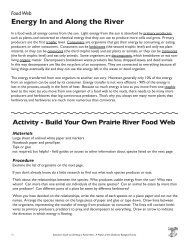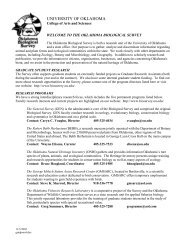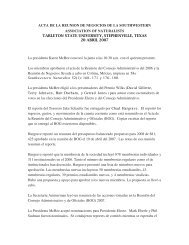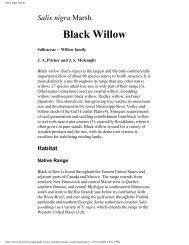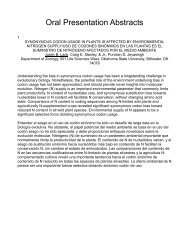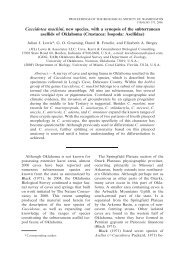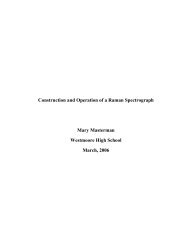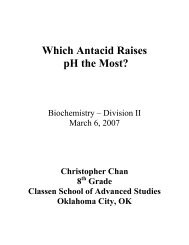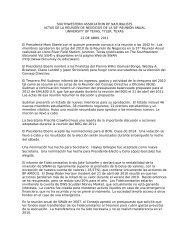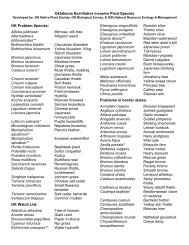Abstract All bacteria undergo constant change or growth. A bacterial ...
Abstract All bacteria undergo constant change or growth. A bacterial ...
Abstract All bacteria undergo constant change or growth. A bacterial ...
You also want an ePaper? Increase the reach of your titles
YUMPU automatically turns print PDFs into web optimized ePapers that Google loves.
stationary phase, and death phase. In the lag phase the cellpopulation remains temp<strong>or</strong>arily un<strong>change</strong>d.1. Lag Phase-Although there is no apparent cell divisionoccurring, the cells may be growing in volume <strong>or</strong> mass.2. Exponential Phase-is a pattern of balanced <strong>growth</strong> whereinall the cells are dividing regularly by binary fission. The cellsdivide at a <strong>constant</strong> rate depending upon the composition ofthe <strong>growth</strong> medium and the conditions of incubation.3. Stationary Phase-Population <strong>growth</strong> is limited by variousfact<strong>or</strong>s. Viable cells are being counted, but cannot bedetermined whether some cells are dying and an equalnumber of cells are dividing, <strong>or</strong> the population of cells hassimply stopped growing and dividing.4. Death Phase-Viable cell population declines. (4)Antibiotics affect the <strong>bacteria</strong>l <strong>growth</strong> curve. The activity ofantibiotics may be classified as “bacteriostatic” <strong>or</strong> “bacteriocidal”.Bacteriostatic drugs stop the cells from growing and multiplying, butdo not actually kill them. Bacteriocidal drugs actually kill the<strong>bacteria</strong>. These drugs are the preferred choice when a person’simmune system is weakened and incapable of destroying the<strong>or</strong>ganism itself. In either case, the antibiotics act by disrupting<strong>bacteria</strong>l cell activity.(4)There are hundreds of antibiotics, most of which belong to eightmaj<strong>or</strong> family groups. The drugs are classified acc<strong>or</strong>ding to their basicchemical structure. Ampicillin is a bacteriocidal, mild broadspectrumantibiotic that belongs to the Penicillin group. Ampicillin isdosed every 4-6 hours. Rocephin is also a bacteriocidal, thirdgeneration cephalosp<strong>or</strong>in that is dosed every 12 hours. Levofloxacinis a bacteriocidal, second-generation quinolone that is dosed every 24hours. (5)The purpose of this research is to determine the death phase of a<strong>bacteria</strong>l <strong>growth</strong> curve after exposure of selected antibiotics. The
three antibiotics used will be Ampicillin (from the penicillin class),Rocephin (a third generation cephalosp<strong>or</strong>in), and Levofloxacin (aquinolone). It is hypothesized that Escherichia coli, a gram negativerod,will have a faster <strong>bacteria</strong>l <strong>growth</strong> curve death phase whenexposed to Rocephin versus Ampicillin and Levofloxacin.MaterialsEscherichia coliSterile watercalibrated loopsgraduated cylindersterile cotton swabsMueller Hinton agar powderautoclavedistilledTryptic Soy brothsterile salinedisposable pipettespipette dispenserAmpicillinRocephinLevaquinsyringeincubat<strong>or</strong>10ul inoculating looptest tubesparafilmwater baththermometerProcedurePart A1. Crush E. coli Kwik Stik and roll onto nutrient agar plate. Streakf<strong>or</strong> isolation.2. Incubate f<strong>or</strong> 24 hrs. at 37 o C.3. Make a .5 McFarland’s Standard by touching a sterilebacteriological loop to 4-5 large m<strong>or</strong>phologically similar, well-
isolated colonies from a 24 hr. agar plate containing E. coli (K-12)4. Emulsify colonies in 10ml of autoclaved distilled water. Captightly.5. V<strong>or</strong>tex suspension 2-3 seconds.6. Make a 1:100 dilution using the serial method.7. Transfer 10ml of saline solution into two tubes labeled A(control) and B (Ampicillin).8. Transfer 10ul from each tube to a nutrient agar plate and streakf<strong>or</strong> colony count. This will be initial colony f<strong>or</strong>ming units/ml.Part B1. Mix Ampicillin and sterile saline acc<strong>or</strong>ding to manufacturersdirections using sterile procedures.2. Transfer .2ml of antibiotic to tube labeled B.3. Set tubes in 37 o C water bath.4. Repeat step 8 (Part A) at 1hr, 2hr, 4hr, 6hr, 8hr, 10hr, 12hr, and24hr. (3 trials each)5. Incubate all plates in 37 o C incubat<strong>or</strong> f<strong>or</strong> 24hrs.6. Count colonies on each plate.Part C1. Dilute Ampicillin at 1:2 (50%) and 1:10 (10%) strength.2. Repeat 2-6 from Part B.3. Repeat Parts A-C f<strong>or</strong> Rocephin and Levofloxacin.Part D1. After <strong>growth</strong> curve is established, repeat testing between timesof last <strong>bacteria</strong>l <strong>growth</strong> and no <strong>growth</strong> to determine a m<strong>or</strong>eprecise time of <strong>bacteria</strong> death.2. Calculate all colony f<strong>or</strong>ming units/ ml by multiplying coloniesby dilution fact<strong>or</strong>.
Colony F<strong>or</strong>ming Units Per MilliliterThe Ampicillin reduced <strong>bacteria</strong>l counts by 45% within 1 hour andhad negative plate cultures at 6hrs and 15 minutes; however itreappeared at 10 hours.The ampicillin at the 50% recommended strength reduced the<strong>bacteria</strong> by 48% at the 1 hour testing and had negative cultures by 6hrs. and 15 minutes; however it began to reproduce again at 8 hours.
tntc = too numerous too countdark bars represent tntcThe ampicillin mixed at the 10% strength of the recommended dosereduced the <strong>bacteria</strong>l by 36% at the 1 hour testing but began t<strong>or</strong>eproduce at the 4 hour testing.The <strong>bacteria</strong>l colonies had reduced by 34% at the 1 hour testing andcontinued to reduce upon negative plate cultures at the 1 hour testing.
The <strong>bacteria</strong> reduced by 29% at the 15 minute testing and had negative platecultures by the 1 hour testing.The <strong>bacteria</strong>l colonies continued to reproduce with a slight reduction of 15%at the 4 hour testing .
The <strong>bacteria</strong> reduced by 88% within 15 minutes and had negative platecultures by 30 minutes.The <strong>bacteria</strong>l colonies reduced by 51% and had negative plate culturesby 30 minutes.
The <strong>bacteria</strong> reduced by 39% at the 15 minute testing and had negativeplate cultures by the 30 minute testing.ResultsThe 5mg/1ml (100%) Ampicillin reduced the <strong>bacteria</strong>l populationfrom 2.92 x 10 6 cfu/ml to 1.61 x 10 6 cfu/ml after 1 hour (45%); howeverthe Rocephin and Levofloxacin killed all <strong>bacteria</strong>l colonies within 1hour. The ampicillin eradicated the <strong>bacteria</strong> within 8 hours; howeverit started to reproduce between 8 and 10 hours and continued t<strong>or</strong>eproduce. The 5mg/1ml (100%) Rocephin and Levofloxacin culturesstayed negative. The .5mg/1ml (10% dilution) Ampicillin nevereradicated the E. coli. The 2.5mg/1ml (50% dilution) Rocephin stayednegative while the Levofloxacin begin to reproduce at 24 hours. <strong>All</strong>antibiotics diluted at the 10% strengths (.5mg/1ml) grew <strong>bacteria</strong>lcolonies within 24 hours.Conclusion and ApplicationsThe hypothesis was not supp<strong>or</strong>ted. The death phase occurredsooner after the <strong>bacteria</strong> were exposed to the Levofloxacin. Rocephineliminated all <strong>bacteria</strong>l colonies by 1 hour, but the Levofloxacineliminated the <strong>bacteria</strong> within 30 minutes. The death phase occurred
in all antibiotics at the 5mg/1ml (100%) and the 2.5mg/1ml (50%)dilution; however at the .5mg/1ml (10% recommended) dilution theAmpicillin did not completely kill the E. coli.Antibiotics are prescribed f<strong>or</strong> illnesses caused by <strong>bacteria</strong>, not byviruses. Prescriptions are written to cover the time needed to helpyour body fight all the harmful <strong>bacteria</strong>. If you stop your antibioticearly, the <strong>bacteria</strong> that have not yet been killed can restart aninfection. If you take antibiotics unnecessarily you may contribute tothe development of antibiotic resistance. Antibiotic resistancecontinues to be a problem in the U.S. If your plan of treatment is notfollowed it will contribute to this growing problem.As seen in this study <strong>bacteria</strong>l infections may <strong>or</strong> may not be curedwith one dose of antibiotics. Hospital lab<strong>or</strong>at<strong>or</strong>ies use similartechniques to determine <strong>bacteria</strong>l susceptibility to differentantibiotics.
Bibliography1. Deacon, Jim. Institute of Cell and Molecular Biology, TheUniversity of Edinburgh. “The Microbial W<strong>or</strong>ld: BacterialColonies, Gram Reaction and Cell Shapes”.2. Deason, Carl. Pharmacist Interview. Grove Drive InPharmacist. October 2, 2005.3. Thomas, Dr. Robert DO. Interview. Integris Grove Hospital.October 10, 2005.4. Kenneth Todar University of Wisconsin Department ofBacteriology. “Growth of Bacterial Populations. (Online)http://textbookofbacteriology.net/<strong>growth</strong>.html5. Levy, Stuart. “The Antibiotic Paradox.” ( New Y<strong>or</strong>k: PlenumPress, 1992).6. Medline Plus. (Online)www.nlm.nih.gov/medlineplus/druginfo7. Reynolds, Jackie. Richland College, Biology Lab Manuel.“Determination of Bacterial Numbers” pg. 141-143.8. Roche Pharmaceutical Lab<strong>or</strong>at<strong>or</strong>ies. Rocephin PackageInsertion., 2006.9. T<strong>or</strong>t<strong>or</strong>a, Gerard, Funk, Berdeli, Case, Christine. AnIntroduction to Microbiology, 1999.



